
Seal brown (horse)
Encyclopedia
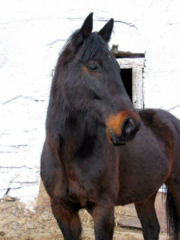
Equine coat color
Horses exhibit a diverse array of coat colors and distinctive markings. A specialized vocabulary has evolved to describe them.While most horses remain the same color throughout life, a few, over the course of several years, will develop a different coat color from that with which they were born...
of horse
Horse
The horse is one of two extant subspecies of Equus ferus, or the wild horse. It is a single-hooved mammal belonging to the taxonomic family Equidae. The horse has evolved over the past 45 to 55 million years from a small multi-toed creature into the large, single-toed animal of today...
s characterized by a near-black body color; with black points, the mane, tail and legs; but also reddish or tan areas around the eyes, muzzle, behind the elbow and in front of the stifle
Stifle joint
The stifle joint is a complex joint in the hind limbs of quadruped mammals such as the sheep, horse or dog. It is the equivalent joint to the human knee...
. The term is not to be confused with "brown", which is used by some breed registries
Breed registry
A breed registry, also known as a stud book or register, in animal husbandry and the hobby of animal fancy, is an official list of animals within a specific breed whose parents are known. Animals are usually registered by their breeders when they are still young...
to refer to either a seal brown horse or to a dark bay without the additional characteristics of seal brown genetics.
The genetically and visually similar dark bay coat color, which also features black points and a near-black body, differs from true seal brown in the absence of these true tan markings. The term "seal brown" is to be distinguished from the term "brown." Another mimic is the liver chestnut
Chestnut (coat)
Chestnut is a hair coat color of horses consisting of a reddish-to-brown coat with a mane and tail the same or lighter in color than the coat. Genetically and visually, chestnut is characterized by the absolute absence of true black hairs...
, an all-over dark brown coat including mane and tail, that is sometimes confused with seal brown. However, true seal browns have black points, while liver chestnuts do not.
The genetic study of seal brown is very new. Several theories were advanced in the last century to explain the heredity of the seal brown coat, and today, true seal brown horses can be distinguished from bays by a DNA test
Genetic testing
Genetic testing is among the newest and most sophisticated of techniques used to test for genetic disorders which involves direct examination of the DNA molecule itself. Other genetic tests include biochemical tests for such gene products as enzymes and other proteins and for microscopic...
.
Identification
The research behind the classification of seal brown as distinct from dark bay is quite new, and as a result, opinions vary on what constitutes a true seal brown. In Equine Color Genetics, Dan Phillip Sponenberg wrote "In general, all dark colors with black points that are lighter than black but darker than bay are called brown." In this text, he classifies black-pointed, clear reddish coats of any shade as bay, and black-pointed coats of any shade with black countershading as brown. These definitions, while precise, are no longer accurate in light of current research.
Terminology
Non-horse people often refer to many horse coat colors as "brown," in particular the bay color. Among horse aficionados, a common assessment is that "...[the term] is only used by people with one horse or with two hundred." The implication is that lay observers will refer to a horse's coat color to be "brown" due to a lack of vocabulary, and those discussing large populations of horses will use "brown" out of a need for a more specific vocabulary. The term "seal brown" is unlikely to be part of a novice's repertoire and is therefore preferable when discussing this specific coat color. This coat color is, illuminatingly, called "black and tanRottweiler
The Rottweiler is a medium to large size breed of domestic dog that originated in Rottweil, Germany. The dogs were known as "Rottweil butchers' dogs" because they were used to herd livestock and pull carts laden with butchered meat and other products to market...
" in some languages.
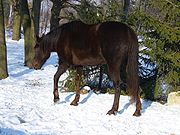
"Brown" but not seal brown
In the most simple terms, the vast majority of horses are indeed some shade of brown, but not "seal brown." Such coat colors include:- ChestnutChestnut (coat)Chestnut is a hair coat color of horses consisting of a reddish-to-brown coat with a mane and tail the same or lighter in color than the coat. Genetically and visually, chestnut is characterized by the absolute absence of true black hairs...
, entirely copper-red to liver-brown, without true black hair. - Bay, reddish-brown to quite dark-brown body coat with true black mane, tail, and legs; dark bays are hard to distinguish from seal browns by even experienced eyes.
- Buckskin, tan or gold body coat with the black areas of a bay (above).
- DunDun geneThe dun gene is a dilution gene that affects both red and black pigments in the coat color of a horse. The dun gene has the ability to affect the appearance of all black, bay, or chestnut -based horses to some degree by lightening the base body coat and suppressing the underlying base color to the...
, commonly tan (though rust or slate-like shades exist) with evident primitive markingsPrimitive markingsPrimitive markings among domestic horses are a group of hair coat markings and qualities associated with primitive breeds, and the dun coat color family in particular. All dun horses possess at least the dorsal stripe but the presence of the other primitive markings varies...
. - Silver dapplesSilver dapple geneThe silver dapple gene is a dilution gene that affects the black base coat color. It will typically dilute a black mane and tail to flaxen, and a black body to a shade of brown or chocolate. It is responsible for a group of coat colors in horses called "silver dapple" in the west, or "taffy" in...
, sometimes called "chocolate", are often found in brownish shades.
Seal browns on paper
Not all breed registriesBreed registry
A breed registry, also known as a stud book or register, in animal husbandry and the hobby of animal fancy, is an official list of animals within a specific breed whose parents are known. Animals are usually registered by their breeders when they are still young...
or studbooks recognize seal brown as a distinct coat color. The American Quarter Horse Association
American Quarter Horse Association
The American Quarter Horse Association , based in Amarillo, Texas, is an international organization dedicated to the preservation, improvement and record-keeping of the American Quarter Horse. The association sanctions many competitive events and maintains the official registry...
and American Paint Horse Association
American Paint Horse Association
The American Paint Horse Association is a breed registry for the American Paint Horse. It is currently headquartered in Fort Worth, Texas. It was founded in 1965 with the merging of two different color breed registries that had been formed to register pinto-colored horses of Quarter Horse bloodlines...
both recognize "brown" as a separate category, while the Arabian Horse Association
Arabian horse
The Arabian or Arab horse is a breed of horse that originated on the Arabian Peninsula. With a distinctive head shape and high tail carriage, the Arabian is one of the most easily recognizable horse breeds in the world. It is also one of the oldest breeds, with archaeological evidence of horses...
labels all non-black
Black (horse)
Black is a hair coat color of horses in which the entire hair coat is black. Black is a relatively uncommon coat color, and novices frequently mistake dark chestnuts or bays for black. However, some breeds of horses, such as the Friesian horse, Murgese and Ariegeois are almost exclusively black...
, black-pointed shades "bay."
Still other registries, such as The Jockey Club
The Jockey Club
The Jockey Club, formed on February 9, 1894, is the keeper of The American Stud Book. It came into existence after James R. Keene spearheaded a drive in support of racehorse trainers who had complained about the Board of Control that governed racing in New York State.-History:On its formation, The...
which registers Thoroughbred
Thoroughbred
The Thoroughbred is a horse breed best known for its use in horse racing. Although the word thoroughbred is sometimes used to refer to any breed of purebred horse, it technically refers only to the Thoroughbred breed...
s and Appaloosa Horse Club
Appaloosa
The Appaloosa is a horse breed best known for its colorful leopard-spotted coat pattern. There is a wide range of body types within the breed, stemming from the influence of multiple breeds of horses throughout its history. Each horse's color pattern is genetically the result of various spotting...
, offer the designation "dark bay or brown" to cope with the ambiguity in terminology and identification. Among historically German breeds and registries, the term rappe indicates a black horse, braun is bay, while dunkelbraun indicates dark bay and schwarzbraun indicates seal brown (literally black-brown).
Related coat colors
The presence of other coat color genes can modify a seal brown coat. The seal brown family includes:- Brown Buckskin, a result of the dilution effect of a single copy of the cream geneCream geneThe cream gene is responsible for a number of horse coat colors. Horses that have the cream gene in addition to a base coat color that is chestnut will become palomino if they are heterozygous, having one copy of the cream gene, or cremello, if they are homozygous. Similarly, horses with a bay...
. Sometimes called brown buckskin. The black areas of the seal brown coat are unaffected or slightly lightened, while the reddish areas are more golden, and may have lighter eyes. Brown buckskins are often quite hard to distinguish from seal browns. - Sable champagne, a result of the dilution effect of the champagne geneChampagne geneThe champagne gene is a simple dominant allele responsible for a number of rare horse coat colors. The most distinctive traits of horses with the champagne gene are the hazel eyes and pinkish, freckled skin, which are bright blue and bright pink at birth, respectively...
. Like all champagnes, sable champagnes have hazel eyes and pinkish, freckled skin. The coat is a flat, diluted grayish- or purplish-brown, somewhere between the warm pumpkin tones of the bay-based amber champagne, and the cool purplish tones of the black-based classic champagne. - Brown dun, a result of the dilution effect of the dun geneDun geneThe dun gene is a dilution gene that affects both red and black pigments in the coat color of a horse. The dun gene has the ability to affect the appearance of all black, bay, or chestnut -based horses to some degree by lightening the base body coat and suppressing the underlying base color to the...
. Like all duns, brown duns have conspicuous primitive markingsPrimitive markingsPrimitive markings among domestic horses are a group of hair coat markings and qualities associated with primitive breeds, and the dun coat color family in particular. All dun horses possess at least the dorsal stripe but the presence of the other primitive markings varies...
including at least a dorsal stripe and darker points. The primitive markings of brown duns are black, and the coat color is somewhere between the slate gray of a grulla and the peanut butter of a bay dun.
Genetics of seal brown
The appearance of a horse's skin, eye, and coat-color is determined by pigment chemicals called melaninMelanin
Melanin is a pigment that is ubiquitous in nature, being found in most organisms . In animals melanin pigments are derivatives of the amino acid tyrosine. The most common form of biological melanin is eumelanin, a brown-black polymer of dihydroxyindole carboxylic acids, and their reduced forms...
s. Two types of melanins are used by mammals, such as horses and humans: eumelanin (YOO-mel-ah-nin), which is visually black to brown, and phaeomelanin (FEE-oh-mel-ah-nin), visually red to yellow. Specialized cells in the skin and eyes, melanocyte
Melanocyte
-External links: - "Eye: fovea, RPE" - "Integument: pigmented skin"...
s or pigment cells, produce melanins and deposit them into the skin and hair using complex chemical reactions. The instructions for these chemical reactions are genetically encoded as DNA
DNA
Deoxyribonucleic acid is a nucleic acid that contains the genetic instructions used in the development and functioning of all known living organisms . The DNA segments that carry this genetic information are called genes, but other DNA sequences have structural purposes, or are involved in...
, and are therefore inherited.
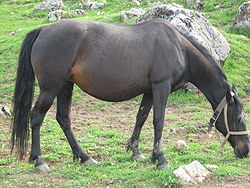
Protein
Proteins are biochemical compounds consisting of one or more polypeptides typically folded into a globular or fibrous form, facilitating a biological function. A polypeptide is a single linear polymer chain of amino acids bonded together by peptide bonds between the carboxyl and amino groups of...
with an important role in eumelanin production is Melanocortin 1 receptor
Melanocortin 1 receptor
The melanocortin 1 receptor , also known as melanocyte-stimulating hormone receptor , melanin-activating peptide receptor, or melanotropin receptor, is a G protein-coupled receptor which binds to a class of pituitary peptide hormones known as the melanocortins, of which include adrenocorticotropic...
(MC1R). The gene
Gene
A gene is a molecular unit of heredity of a living organism. It is a name given to some stretches of DNA and RNA that code for a type of protein or for an RNA chain that has a function in the organism. Living beings depend on genes, as they specify all proteins and functional RNA chains...
which encodes a functional MC1R protein occupies the Extension locus
Locus (genetics)
In the fields of genetics and genetic computation, a locus is the specific location of a gene or DNA sequence on a chromosome. A variant of the DNA sequence at a given locus is called an allele. The ordered list of loci known for a particular genome is called a genetic map...
, or chromosomal position, and is symbolized by the capital E. A mutation
Mutation
In molecular biology and genetics, mutations are changes in a genomic sequence: the DNA sequence of a cell's genome or the DNA or RNA sequence of a virus. They can be defined as sudden and spontaneous changes in the cell. Mutations are caused by radiation, viruses, transposons and mutagenic...
, or change, in the equine MC1R gene, that resulted in a non-functioning MC1R protein, was identified in 1996. This form of the gene is symbolized by the lowercase e or sometimes Ee. Since each horse has two copies of the MC1R gene, one from each parent, horses with one "broken" copy (e) can still produce eumelanin in the hair. However, if a horse has two copies of the "broken" allele
Allele
An allele is one of two or more forms of a gene or a genetic locus . "Allel" is an abbreviation of allelomorph. Sometimes, different alleles can result in different observable phenotypic traits, such as different pigmentation...
and therefore no copies of the functional E allele, the horse is completely incapable of depositing black pigment in the hair. Such horses are chestnut
Chestnut (coat)
Chestnut is a hair coat color of horses consisting of a reddish-to-brown coat with a mane and tail the same or lighter in color than the coat. Genetically and visually, chestnut is characterized by the absolute absence of true black hairs...
, or at least, are not black
Black (horse)
Black is a hair coat color of horses in which the entire hair coat is black. Black is a relatively uncommon coat color, and novices frequently mistake dark chestnuts or bays for black. However, some breeds of horses, such as the Friesian horse, Murgese and Ariegeois are almost exclusively black...
, bay, or seal brown.
The gene with the greatest role in the seal brown coat phenotype is Agouti signalling peptide
Agouti signalling peptide
Agouti signalling peptide, a product of the Agouti gene, is a peptide consisting of 131 amino acids. Its discovery was published in 1994 in the scientific journal Nature where its functional properties were described...
(ASIP) or simply Agouti. The functional Agouti signalling peptide (protein) acts as a switch between red-yellow phaeomelanin and black-brown eumelanin. It is ASIP that is responsible for the alternate banding of dark and light on animal hair, although it is also responsible for whole-body effects. ASIP attaches to MC1R molecules to temporarily prevent the latter from continuing the production of eumelanin, and so phaeomelanin is produced in its stead. Although an individual horse can only have two copies of the Agouti gene, there are four alleles or options:
- A+ (wildtype, dominant) highly restricted black points such as those seen in Przewalski's horses.
- A (mutation, 2o dominant) restricted black points, responsible for standard bay.
- At (mutation, 3o dominant) poorly restricted black points, responsible for seal brown.
- a (mutation, recessive) unrestricted black points, uniformly black coat.
The A and At alleles can be identified by DNA test. To be seal brown, a horse must have at least one copy of the functional MC1R gene (E/E or E/Ee) and must have one of the following genotypes at the Agouti locus: At/At or At/a.
Bay horses also possess at least one copy of the functional MC1R gene (E/E or E/Ee) but will possess one of the following genotypes at the Agouti locus: A/A, A/At, or A/a. While they may possess one copy of the At allele, its effects are not visible when a copy of the dominant Agouti allele is present.
Former theories about the genetics of seal brown
An early version of the currently-accepted equine Agouti gene theory was first presented in 1951 by Miguel Odriozola in A los colores del caballo, subsequently reviewed by William Ernest Castle in GeneticsGenetics (journal)
Genetics is a monthly scientific journal publishing investigations bearing on heredity, genetics, biochemistry and molecular biology. Genetics is published by the Genetics Society of America...
. This theory prevailed until the 1990s, when discoveries of similar conditions in other species provided alternate explanations.
Black and pangaré
For a period, the seal brown phenotype - black or near-black coat with tan or red hairs on the soft areas - was described as a true blackBlack (horse)
Black is a hair coat color of horses in which the entire hair coat is black. Black is a relatively uncommon coat color, and novices frequently mistake dark chestnuts or bays for black. However, some breeds of horses, such as the Friesian horse, Murgese and Ariegeois are almost exclusively black...
coat affected by pangaré
Pangaré
Pangaré is a coat trait found in some domestic horses that features pale hair around the eyes and muzzle and underside of the body. These pale areas can extend up to the flanks, throat and chest, behind the elbows, in front of the stifle, and up the buttock. Animals with the pangaré trait are...
, or mealy-factor. Pangaré is a quality common to the Przewalski's horse
Przewalski's Horse
Przewalski's Horse or Dzungarian Horse, is a rare and endangered subspecies of wild horse native to the steppes of central Asia, specifically China and Mongolia.At one time extinct in the wild, it has been reintroduced to its native habitat in Mongolia at the Khustain Nuruu...
and so-called primitive horse breeds such as the Exmoor Pony
Exmoor pony
The Exmoor pony is a horse breed native to the British Isles, where some still roam as semi-feral livestock on Exmoor, a large area of moorland in Devon and Somerset in southwest England. The Exmoor is one of the British Isles mountain and moorland pony breeds, having conformation similar to that...
. The trait is characterized by pale hairs, typically off-white to light tan, around the eyes, muzzle, and underside of the body. By this definition, seal browns would possess the recessive a/a Agouti genotype. Dan Phillip Sponenberg described seal browns in this way, suggesting that dark browns - by his definition, sooty bays - could be distinguished from seal browns by a quality of redness, stating "[the] mealy effect generally is lighter and more yellow than residual nonblack areas (which tend to be redder) on very sooty horses."
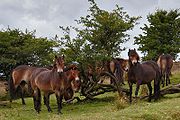
Tyrosinase-brown
Tyrosinase-related protein 1TYRP1
Tyrosinase-related protein 1, also known as TYRP1, is an enzyme which in humans is encoded by the TYRP1 gene- Function :Tyrp1 is a melanocyte-specific gene product involved in melanin synthesis. Mouse Tyrp1 possesses dihydroxyindole carboxylic acid oxidase activity, The function in human...
(TYRP1) is a protein
Protein
Proteins are biochemical compounds consisting of one or more polypeptides typically folded into a globular or fibrous form, facilitating a biological function. A polypeptide is a single linear polymer chain of amino acids bonded together by peptide bonds between the carboxyl and amino groups of...
involved in melanin synthesis, and is encoded by the TYRP1 gene, also called the brown (b) locus
Locus (genetics)
In the fields of genetics and genetic computation, a locus is the specific location of a gene or DNA sequence on a chromosome. A variant of the DNA sequence at a given locus is called an allele. The ordered list of loci known for a particular genome is called a genetic map...
. In humans, mutation
Mutation
In molecular biology and genetics, mutations are changes in a genomic sequence: the DNA sequence of a cell's genome or the DNA or RNA sequence of a virus. They can be defined as sudden and spontaneous changes in the cell. Mutations are caused by radiation, viruses, transposons and mutagenic...
s in the TYRP1 gene account for variations in "normal" skin, hair and eye coloration, as well as types of clinical Albinism
Albinism
Albinism is a congenital disorder characterized by the complete or partial absence of pigment in the skin, hair and eyes due to absence or defect of an enzyme involved in the production of melanin...
. Mutations in the TYRP1 gene of other mammals result in various reddish-brown coat color phenotypes: Brown in mice, Chocolate in cats, Chocolate in dogs, and Dun in cattle.
The phenotypes associated with TYRP1 mutations are typically rufous or chocolate rather than the black-dominated coats of seal brown horses, and usually result in pinkish-brown skin and light eyes. This is not the case for seal brown horses, and the role of TYRP1 in seal brown was ruled out after it was sequenced in 2001.
Extension-brown and dominant black
The allure of a pure black coat on a horse has struck horse breeders for centuries, resulting in all-black breeds like the Friesian horseFriesian horse
The Friesian is a horse breed originating in Friesland, Netherlands. Although the breed's conformation resembles that of a light draft horse, Friesians are graceful and nimble for their size. During the Middle Ages, it is believed that the ancestors of Friesian horses were in great demand as war...
. The breeding of pure black horses is attended by two problems: some black coats fade with exposure to light and sweat, and breeding two "black" horses together would sometimes produce non-black horses. In some cases, faded true black horses have lighter coats than the darkest near-black horses.
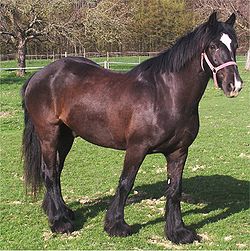
Similarly, D.P. Sponenberg suggested an Extension-brown (EB) allele, dominant over the wildtype E. He described an allele responsible for black countershading, or sootiness, which would distinguish all shades of brown from all shades of bay.
Both theories were laid to rest after the characterization of the equine MC1R or Extension, which showed no such alleles. However, it remains likely that a genetic control for sootiness does exist.
Dark bay vs. seal brown
Bay horses, which have a black mane, tail, and legs with a mixture of red and black hairs on the body coat, have one of several genotypes at the Agouti locus: A/A, A/At, or A/a. Seal brown horses, which have primarily black coats in addition to black "points", with reddish or tan hairs around their muzzle, eyes, girth and flanks, have one of two different genotypes at the Agouti locus: At/At or At/a. Both coat colors exhibit a broad range of potential shades due to a variety of factors including the bleaching or fading of black hair, nutrition, and the presence of sooty or countershadingCountershading
Countershading, or Thayer's Law, is a form of camouflage. Countershading, in which an animal’s pigmentation is darker dorsally, is often thought to have an adaptive effect of reducing conspicuous shadows cast on the ventral region of an animal’s body...
factors.
Many black horses fade, sunbleach, or otherwise undergo a lightening of their coat color with exposure to sunlight and sweat. Horses which do not undergo such fading may be called jet black, raven black, non-fading black, or sheer black. Furthermore, the black areas of horses that are not uniformly black may be subject to the same fading effects. A non-fading dark bay might then be darker than a sunbleached seal brown. Mineral and vitamin deficiencies can also contribute to a lighter coat, similar to sunbleaching.
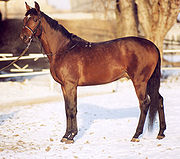
Countershading
Countershading, or Thayer's Law, is a form of camouflage. Countershading, in which an animal’s pigmentation is darker dorsally, is often thought to have an adaptive effect of reducing conspicuous shadows cast on the ventral region of an animal’s body...
. Horses without any sootiness are termed "clear-coated". Sootiness can be minor or quite extensive, and often includes dappling. Dark bay horses are typically sooty. The difference between the top-down distribution of the sooty trait and the lighter soft areas of a seal brown can also be difficult to distinguish from one another.
The team of French researchers who developed the DNA test for the recessive a allele also discussed the possibility that Extension might be dosage-dependent. They found a statistically significant tendency for lighter bays to be heterozygous for the dominant, wildtype Extension allele (E/e, also written E+/Ee) while darker bays were more often homozygous (E/E). The authors acknowledged that other factors could play a role, and that the claim needed to be studied on a greater scale. This type of dosage-dependent behavior was not observed with Agouti.

